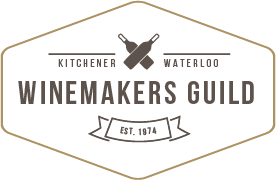Getting ready
Ensure that you have equipment cleaned and supplies on hand.
Equipment – crusher/destemmer, wine press, primary fermenter, carboys, air locks, hydrometer, siphoning hose, funnel, large spoon or something to press wine down with,
Supplies – yeast, Go ferm, Fermade, pectic enzyme, ColorPro, ColorX, Opti Red/White, SO2, Acidex, chromatography test kit, acid test kit.
Determine style of wine desired – may depend on grapes received
Buy best grapes available – crush and de-stem as soon after picking as possible
Crush and destem
Crush and destem grapes
Add enzymes (pectic, ColorPro, ColorX) (color Pro for lighter reds and Color X for big reds to break down the grapes. Many are using color pro for everything)
Add SO2 (25ppm) ¼ teaspoon/pail
Check for brix, Ph and acid levels
Adjust if needed (Adjust before fermentation)
Add 11g/lt sugar to increase brix by 1 (22-25 for reds will give 12 to 13.8% alcohol)
PH looking for 3.2 – 3.6 range
TA for reds, looking for 6. – 7.5 initially for reds (malo and cold stabilization will drop 1g/lt)
TA for whites, looking for 6.5 – 9 depending on wine style
Use tartaric acid to increases 1g/lt will raise TA 1
Use acidex or comparable to reduce acid. Use table to calculate volume of acidex and wine
Do a cold soak – Put crushed grapes in a cold (1to 5C) area for 36-72hr. This will add in colour extraction.
Fermentation
Determine what you want finished product to be like.
Select yeast strain best suited to desired finished product.
Warm must to 17 – 20C
Use a primary fermentation vessel with lid or air lock to ensure that a blanket of CO2 covers the must. Try to keep oxygen away from must. When fermenting, the must generates CO2 protecting it from oxygen.
Prepare a yeast starter
Begin yeast culture (5g yeast/carboy, 5g GoFerm in 10 times its weight in 40`C H2O)
Wait until water reaches 37.5`C, add yeast culture and wait 15 min. Add 30ml juice@20`C (double volume). Add 60 ml of juice (doubling vol. & time until you reach 10% volume of total to ferment) now have 120 ml. Wait 1 hr and add 120 ml juice to culture (now you have 240 ml culture/juice). Wait 1 hrs & add 240 ml juice (now at 480ml). Wait 1 hrs & add 480 ml of juice (now at 960). Wait 1 hrs and add to wine bulk (this process ensures healthy yeast cell to start with) the starter should be the same temperature as the bulk must
Monitor temperature. In first few days- temp should rise to 27-28C do not let it get over29-30C max. Let it ferment at 28C for two days and then take temp. down to approx. 20C+or- for balance of fermentation in order to maintain fruit.
Rehydrate malo culture. Add Opti malo and malo culture to wine at end of day 2 of fermentation.
Punch down cap 3 times daily throughout fermentation to keep skins hydrated.
24 hours after fermentation is going feed 3-4gr of fermaid per 20lt to must. At the 48hr mark add another 1-3gr/lt of fermaid. The fermaid provides nitrogen for the yeast. Fermaid will only work in the first 1/3 of fermentation.
Monitor nose and SG daily. At ½ to 2/3 way through fermentation (approx. SG1040) add 5g DAP. If Hydrogen sulphide (rotten eggs) H2S noticed double amount of DAP.
Optional – take off seeds at SG 1025 to 1020 to eliminate bitter tannins from seeds
Monitor SG and when it gets down to approx SG 1.05 to 1.0 press juice into pails or carboys. (should yield 13-15lt/bushel) ensure that carboys are topped up and let it finish fermenting down to dry (SG .992-994).
Ensure airlock remains full of water and let wine settle in cold temperature (5-10C) for 24-48hr. Rack off gross lees to get clean wine.
Finishing
Add bentonite and let it finish going through malolactic fermentation and clear at the same time. Maintain at 18-20C to allow malo to finish. Malo will not work in cold temp or with high SO2 levels. At end of 3 weeks check to see if malolactic fermentation is complete. Do chromatography test to ensure completion of malo. Rack off lees and add 70ppm SO2.
Leave for 4-6 weeks at 0-3C temp to allow for cold stabilization and for wine to drop its excess tartaric acid.
Wine should be 90% clear by now. Rack off sediment.
Check SO2 levels in relationship to PH
Recheck TA and PH levels and adjust if needed. Finished red wine acid levels should be 5 to 6.5. taste for balance.
Bulk age in barrel or carboy with oak chips (2-5gr/lt. depending on desired level of oak)
Aging in a barrel will provide micro oxidization which is a part of the aging process. Ensure that the barrel is topped up weekly and that SO2 levels are maintained at 50ppm.
After bulk aging, rack off sediment.
If you are going to blend with other red wines let it bulk age for another couple of months as it will generate new sediment even if all wines blended together were perfectly clear.
Bottle and label when ready. Always rack to clean carboy before bottling.
Produce enough so that you can put some into long term storage 5-10 years.
Prepared by
Steve McDonald

